In 1834, a tall observation tower was opened to the public near to Trafalgar Square giving people a chance to look down on Pall Mall and overlook St James Park and Whitehall. For a shilling, anyone could ascend its 168 steps to the top and walk around a walkway to admire the views.
A twin to its taller counterpart in the City of London, it closed to the public within just a couple of decades. However, this observation tower remains in place, in full view of thousands of people who pass by everyday unaware that its stony exterior conceals a staircase of delights.
For something like 130 years it has stood alone and empty.
This is in fact, the Duke of York Column – and it is still there, standing silent sentinel over The Mall.
The hint that this stone column might contain a hidden interior can be spied by the metal railing around the top, which recalls the walkway at the top of The Monument. There is also the wooden door in the base of the column, which has been variously described as concealing a cupboard, a boiler room, or even a secret staircase to underground tunnels.
In fact, it conceals a short corridor that leads to a stone spiral staircase leading to the summit of the tower.
If you look around the tower you can also spy small slots in the stonework – the windows that permit beams of light within.
That the tower conceals a staircase is also less obvious to the casual observer due to the apparent lack of a door at the top. There is a door there, but it is not on the front/rear which are so often and easily photographed. In fact, you have to walk along Carlton House Terrace and look up at the right angle – and there you can just about see the doorway if you have binoculars (or a good zoom lens on the camera).
So how did what most people think of as just another statue to a long-dead person end up here, and with an observation balcony?
The tower was erected following a public subscription which raised £21,000 in 1829 to the memory of the late Duke of York, and after a number of designs were submitted, the final version by a Mr Wyatt was approved in December 1830.
The column itself was erected by Messrs Nowell of Pimlico for the cost of £15,760 with construction starting in April 1831 and being finished 20 months later. The column is mounted on top of a huge concrete foundation pyramid, of which the stairs down to The Mall are mounted on one side.
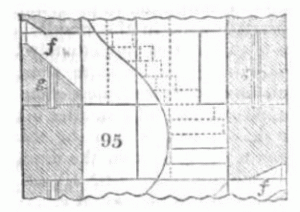 The pedestal at the base of the column is 16 feet 8 inches high and made of ten courses of Aberdeenshire grey granite. The column itself is assembled from 26 courses of Peterhead red granite, and the slots which are actually windows for the interior staircase are marked as f on the drawing.
The pedestal at the base of the column is 16 feet 8 inches high and made of ten courses of Aberdeenshire grey granite. The column itself is assembled from 26 courses of Peterhead red granite, and the slots which are actually windows for the interior staircase are marked as f on the drawing.
The construction of the main column was completed in December 1833, although the statue was not put at the top until the following April. During the construction, a large scaffold had been erected, but this was removed before the statue arrived, so they used a hoist to raise that to the top.
There is a metal railing around the top of the viewing platform and it was from here that the public could look out over St James Park and the newly developed Regent Street.
The column was opened to the general public on the 23rd April 1834 at a cost of a shilling per person, with the funds being used to support the widows and orphans of soldiers.
In 1837, this was the view of London from the top of the column, looking eastwards and printed in The Penny Magazine. Amusingly, one of the tallest structures that can be seen in the distance is the column’s city rival – the Monument.
This is what the view from the top of the column would have looked like in 1845 – facing northwards. This huge panorama was printed in the London Illustrated News (click for larger version).
Sadly, the top of the column eventually became the site for at least one known suicide (and I infer possibly more), and in 1850, the top railings were adapted to the same total enclosure that The Monument has long sported – although they were later removed when the viewing platform closed.
The column very nearly didn’t survive much longer after that incident – as in 1856 and again in 1904, Parliament considered road improvements in the West End, and one of the proposals that was seriously considered debated extending Regents Street down over Pall Mall and to The Mall itself – and in the process driving a road through Waterloo Place, digging out the steps and replacing them with a sloping road.
I haven’t been able to find out exactly when the column closed to the public, but in April 1886, there was a House of Commons debate that noted: “Until a few years ago there was a keeper, who admitted persons to ascend the Column through a door on the park side, which has now become dilapidated. The keeper no longer exists, and the Column is closed to the public;”
If the column closed around 1880 — then with a few exceptions for inspections — the wooden door at the base has been locked for around 130 years. In fact so rarely has anyone been inside, that I have utterly failed to locate any contemporary photos of the interior staircase. Even a visit by a structural survey team in 2006 only took photos of problems, not the rest of the interior.
In 1888, the column ownership was transferred to the Commission of Works and Public Buildings. It is now part of St James Park and managed by the Royal Parks.
Almost exactly 100 years ago – in December 1912 an MP asked if the Column could be reopened to the public, and Tony Benn’s father William Wedgwood Benn MP said that it would be looked into. Evidently, nothing happened.
Could it be reopened again?
Well, firstly, why did it close? I suspect that while Monument was sited next to the Pool of London, and the cargo ships brought in curious sailors keen to see the city – the Duke of York stood in posh London in an age where tourism by the masses simply didn’t exist.
It was even designed to make climbing easier by reversing the spiral of the staircase to anti-clockwise, but that wasn’t enough to encourage visitors.
Today though, the column stands in a tourist hotspot of almost unimaginable potential. Unlike the Monument, there isn’t enough space inside the column itself for ticket sales, but they could be sold by the nearby ICA or Mall Galleries and checked by a sentry by the doorway. Maybe.
Personally, I think it would be splendid to see it open again – if someone can find a way of paying for the necessary repairs and upgrades. Until then, Frederick, Duke of York will gaze out over Whitehall alone.
Key references
The Mechanic’s Magazine, Aug 1834
Saunterings in and about London, 1853
Report from Parliamentary Select Committee on St. James’s Park, 1856


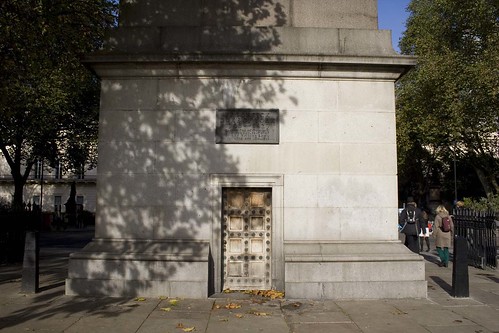

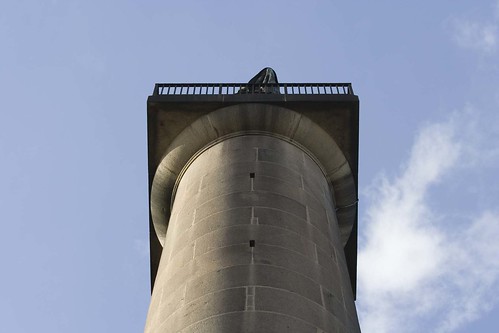
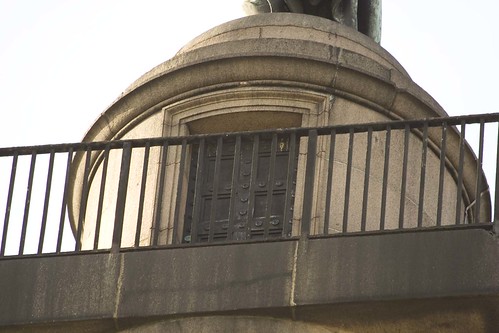
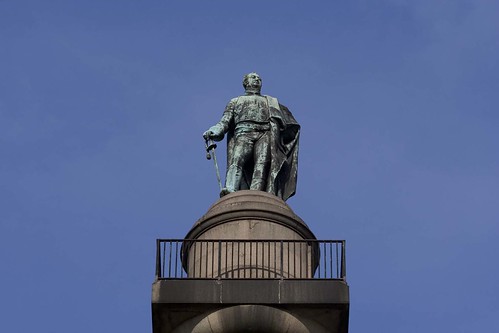
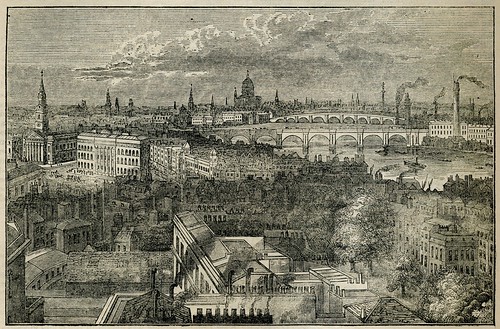

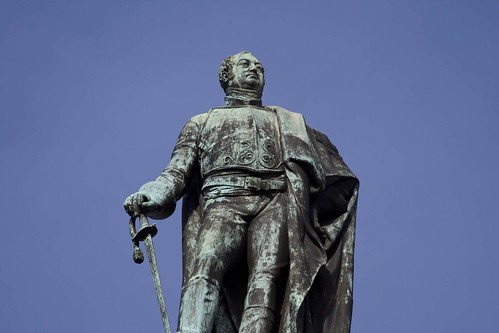






it must be easier to re-open than some of those disused tube stations that that guy Ajit Chambers was planning.. what ever happened to him?
He is still working on the plans for those – opening disused stations is VERY difficult.
I have walked past this many times and never knew the history. Fascinating, thank you.
It would be great to see it open again.
Someone has been up there recently, if this Google Places/Plus photo is to be believed…
https://plus.google.com/103331820348079837634/about?gl=uk&hl=en
How did they get up there? What an intriguing picture…
As I noted in the article, people carried out a survey in 2006 – so the photo may be from that visit.
There was also scaffolding up a few years ago when a number of ‘urban explorers’ were caught on their way down. Probably some photos knocking about from them.
I hope they get it open to the public again. I recently went into a tower like this in Astoria, Oregon. However, being deathly afraid of heights, I was only able to go about a foot from the door at the top before skittering back down the stairs. 🙂
At least you got that far and tried.
Too many folk just give up/in and miss memorable views etc..
The first paragraph says it opened in 1844, but the rest of the article quotes 1834.
Corrected. Thanks.
interesting cross section of the tower: http://www.1st-art-gallery.com/Benjamin-Dean-Wyatt/Cross-Section-Of-The-Duke-Of-Yorks-Monument,-Carlton-Gardens,-London,-1831.html
Wonderful! Thank you!
I hadn’t realised the railings round the top were a viewing platform. Like so many statues of ‘great’ men that you’ve never heard of, I walk right past this without even looking.
Being the proud owner of a certificate to say I’ve climbed the 311 steps of the Monument, I now want another one for this tower.
You can see it clearly enough in this photo
http://i47.tinypic.com/fuxcwp.jpg
I think I took it from the top of NZ House
Which also had a viewing gallery open to the public. As teenagers we often went up- it was free – and it was the tallest building in London in the sixties
My uncle John Lake was a stonemason and worked for the Ministry of Works London for 50 years – I have a daily mail photo of him on the top of this monument also one of him on top of Nelsons Column looking Nelson in the eye.
Hi John, I’m doing some research for my postgraduate degree on this monument, It would be great if I could get the chance to see these photographs!
I was lucky enough to visit the tower sometime in the very early 1970’s,someone’s dad worked for a tv/film company,someone there had heard about tower and wanted to use it as a camera point for car/helicopter chase in a film,it was grey,freezing cold, couldn’t see much and the most memorable thing was how filthy and cold it all was..
I remember commenting on this when it was first posted 5 years ago!